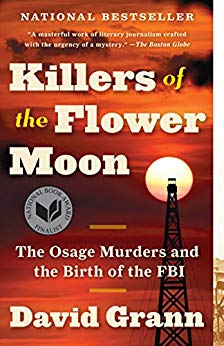

This article is an excerpt from the Shortform summary of "Killers of the Flower Moon" by David Grann. Shortform has the world's best summaries of books you should be reading.
Like this article? Sign up for a free trial here .
Are you leading a Killers of the Flower Moon discussion? What questions will spark an engaging and thoughtful conversation?
Killers of the Flower Moon: The Osage Murders and the Birth of the FBI is about the Osage Reign of Terror—a series of organized killings in Osage County, Oklahoma, during the 1920s. The victims were members of the Osage Indian tribe, and the motive was profit.
Continue reading to find Killers of the Flower Moon discussion questions that you can use for yourself or in a group.
Killers of the Flower Moon Discussion Resources
We’ve included seven Killers of the Flower Moon discussion questions below, and we’ve included a summary of the major themes in the book to help you develop your own Killers of the Flower Moon book club questions.
Killers of the Flower Moon Summary & Themes
Throughout a five-year period of mayhem and slaughter running from approximately 1921-1926, prominent white members of the community conspired to murder their Osage neighbors—men, women, and children.
The motive for these murders was profit—specifically the oil wealth of the Osage, which they had come into when oil was discovered on their reservation in the late 19th century.
The murders were also the catalyst for a major reformation of American law enforcement. The Bureau of Investigation (the predecessor agency of the FBI) and its fiercely ambitious director, J. Edgar Hoover, used the high-profile Osage case to assert the role of the federal government in the world of local law enforcement on an unprecedented level. Make sure to consider the role of law enforcement when forming your Killers of the Flower Moon discussion questions: more on that below.
Financial and Cultural Exploitation
It’s important to think about the racism the Osage faced when creating your Killers of the Flower Moon discussion questions. The tribe had suffered the loss of its tribal lands and been decimated by both smallpox epidemics and military defeats by the United States throughout much of the century. But, overnight, the oil discovery turned the tribe into one of the wealthiest per-capita groups in the world, with the total tribal income from leases to the oil companies running into the tens of millions and leases on individual tracts climbing as high as $2 million.
The wealth of the Osage, however, attracted the jealousy and greed of whites in Oklahoma. These attitudes would soon be given the force of law. In 1921, Congress instituted a financial guardianship system, under which Osage people were declared financially “incompetent” and unable to spend their own money as they saw fit.
The courts appointed guardians, usually drawn from the ranks of white attorneys, politicians, and bankers in the community, who would guard the Osage assets. This system kept the Osage in day-to-day poverty, despite being wealthy on paper—while providing ample opportunities for whites to embezzle and defraud them through a variety of schemes. By 1925, the government estimated that unscrupulous guardians had swindled the Osage out of $8 million.
The guardianship system was not the only way in which the paternalistic white authorities sought to “help” the Osage. In Oklahoma, the federal government ran a program of forced cultural assimilation. The ostensible goal of this program was to help integrate the Osage into mainstream American (i.e., white) society.
The real purpose, however, was to wipe out any traces of Osage religion and language—especially among children. Official government policy stipulated that native peoples like the Osage were morally and culturally unfit for self-government, and needed to be taught the ways of the white man in order to fully participate in American economic and political life. Thus, young Osage were forced to attend schools (often Christian parochial schools), where they would be taught to reject traditional Osage religion and culture, to be remade in the white man’s image.
These schools were English-only—children were not allowed to speak the language of their ancestors inside the walls of these harsh and forbidding institutions. By the early 1920s, speakers of the Osage tongue were dwindling, traditional modes of dress had all but disappeared, and most members of the tribe had converted to Christianity, with only faint vestiges of the old religion still observed.
The Failures of Local Law Enforcement
Another topic for your Killers of the Flower Moon discussion questions is the failures of law enforcement. In these parts of rural Oklahoma in the 1920s, elements of the frontier justice system still remained. Police forces were not yet fully professionalized, so ordinary citizens still assumed some of the responsibilities of criminal justice, including the investigation of evidence and even the pursuit of suspects. For your Killers of the Flower Moon book. club questions, you can even read up on the history of law enforcement.
This was how law enforcement and criminal justice were still practiced in remote parts of the American West, even as late as the 1920s. Many rural sheriffs were not professionally trained law enforcement officials, but were instead rugged frontiersmen, so-called “lawmen” who were often corrupt, violent, and connected to criminal elements within their jurisdiction. Private investigators were not much better. Many agents of the famed Pinkerton Detective Agency were criminals themselves, with no respect for people’s civil liberties or proper protocol in criminal investigations. Many, similarly, used their position to extort and terrorize the very people they were meant to be protecting.
As the death toll rose and more Osage were killed, it became clear that state and local law enforcement was either too incompetent or corrupt to restore order and safety in Osage County.
Killers of the Flower Moon Discussion Questions
With these three Killers of the Flower Moon book club questions, you can explore how bias and prejudice shape our world.
- Have you ever been in a situation where you felt you needed to hide or tone down some part of your identity, as the Osage were forced to? Briefly describe the situation.
- How did you respond?
- How would you resist pressure to subsume your identity in future situations?
With these four Killers of the Flower Moon discussion questions, you can explore the main takeaways from the book.
- Why do you think local law enforcement was so ineffective in solving the Osage murders?
- Briefly describe how the FBI’s prosecution of the Osage case was a major turning point in the history of American law enforcement.
- Why do you think Tom White was able to overcome the prejudices of a white man of his time and place and genuinely pursue justice for the Osage?
- Can you think of a modern parallel to the Osage murders? In a few sentences, explain how the Osage case shares similarities with your example.
Every April, millions of tiny flowers burst into life across the vast plains of Osage County, Oklahoma. But their beauty is short-lived—In May, larger flowers bloom, killing the smaller ones by choking out their access to life-giving sun and water. This is why the Osage call May “the time of the flower-killing moon.” In 1921, May was to signal the start of a far more sinister season of death.
We hope that these Killers of the Flower Moon discussion questions help you guide your own discussion or inner dialogue as you break down the many factors that led to this tragedy. You can examine the themes of corrupt law enforcement and the cultural and financial exploitation of the Osage, and you can develop your own Killers of the Flower Moon discussion questions, as well.

———End of Preview———
Like what you just read? Read the rest of the world's best summary of David Grann's "Killers of the Flower Moon" at Shortform .
Here's what you'll find in our full Killers of the Flower Moon summary :
- How the Osage tribe had vast oil wealth, but had it seized by their murderous neighbors
- The brutal and unresolved murders of Osage Native Americans
- The complicated history of the FBI in profiting from the Osage murders






